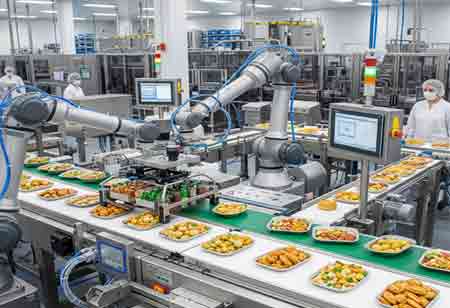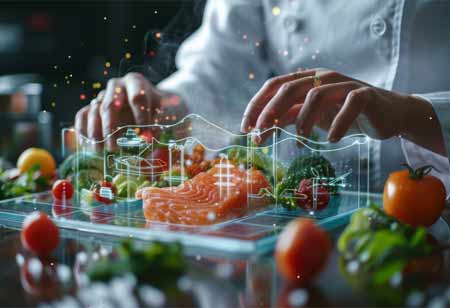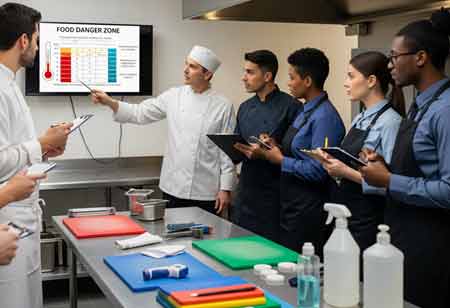THANK YOU FOR SUBSCRIBING
Be first to read the latest tech news, Industry Leader's Insights, and CIO interviews of medium and large enterprises exclusively from Food and Beverage Tech Review
Automation as the New Standard in Reengineering the Food Supply Chain
The food production industry is undergoing a transformation driven by automation, including robotic systems and smart machinery, which enhances efficiency, hygiene, and safety, while also addressing labor challenges in food handling.

By
Food and Beverages Tech Review | Tuesday, November 25, 2025
Stay ahead of the industry with exclusive feature stories on the top companies, expert insights and the latest news delivered straight to your inbox. Subscribe today.
Fremont, CA: In the food production, a silent revolution is underway. The traditional image of a bustling factory floor, filled with manual labor, is being replaced by a sophisticated ballet of robotic arms, intelligent conveyors, and precision-engineered machinery. This transformation, driven by the convergence of mechanical and robotic food handling equipment with advanced food processing solutions, is not just about automation; it's about reimagining the very foundations of efficiency, hygiene, and safety in the food supply chain.
The Core Components of the Automated Food Handling Ecosystem
The shift towards automation in the food industry is being driven by the seamless integration of advanced technologies that are redefining efficiency, precision, and product quality. At the forefront are robotic food handling systems, which serve as the backbone of modern plants. Equipped with specialized grippers and vision systems, these robotic arms handle delicate tasks such as picking pastries or sorting bulk produce with remarkable speed and accuracy, far surpassing manual capabilities. The result is higher throughput, reduced labor dependency, and minimized product damage—a critical advantage when dealing with perishable goods. Complementing this are conveyor systems and smart machinery, which function as the circulatory network of automated facilities. No longer limited to basic product transport, today’s conveyors integrate sensors and intelligent software to detect, reject, or reroute defective items, ensuring a seamless production flow. Smart equipment, including automated slicers, peelers, and fillers, delivers precise and consistent output, minimizing waste and ensuring uniformity throughout the process. Finally, advanced processing and packaging solutions bring transformation and finishing efficiency to the production line. From automating complex processes such as mixing, cooking, and freezing, to utilizing robotic pick-and-place systems for packaging and automated palletizers for shipping, these solutions enhance both productivity and reliability.
Key Improvements Transforming the Industry
The integration of advanced technologies is delivering transformative benefits across the food production chain. Automation enables unprecedented efficiency and throughput, with 24/7 operations and minimal downtime, ensuring consistent output at significantly lower operational costs. Robotic systems not only boost production volumes but also enhance reliability, allowing companies to meet growing market demands more effectively. Equally critical is the improvement in hygiene and food safety: by reducing direct human contact with food and leveraging enclosed, easily sterilizable equipment, automation minimizes the risk of contamination while meeting stringent standards such as HACCP. These advancements also address pressing labor challenges. In an environment of skilled labor shortages, automation alleviates the burden of repetitive, physically demanding tasks, enabling employees to focus on higher-value responsibilities, such as quality control, maintenance, and strategic planning—all while enhancing workplace safety. The precision of smart machinery reduces spillage, ensures accurate portioning, and minimizes waste, thereby improving consistency and sustainability across operations. Integrated systems with sensors and data analytics enhance traceability and quality control by enabling real-time monitoring of critical parameters, including temperature, weight, color, and shape.
The future of food handling and processing is undoubtedly automated. As technology continues to evolve, we will see even more sophisticated applications of robotics and smart machinery, from AI-powered quality inspection systems to fully autonomous production lines. This shift is not just about adopting new technology; it’s about building a more resilient, efficient, and safer food supply chain for everyone. The automated kitchen is no longer a futuristic concept—it is a present-day reality, fundamentally reshaping how we produce, handle, and consume food.
I agree We use cookies on this website to enhance your user experience. By clicking any link on this page you are giving your consent for us to set cookies. More info







